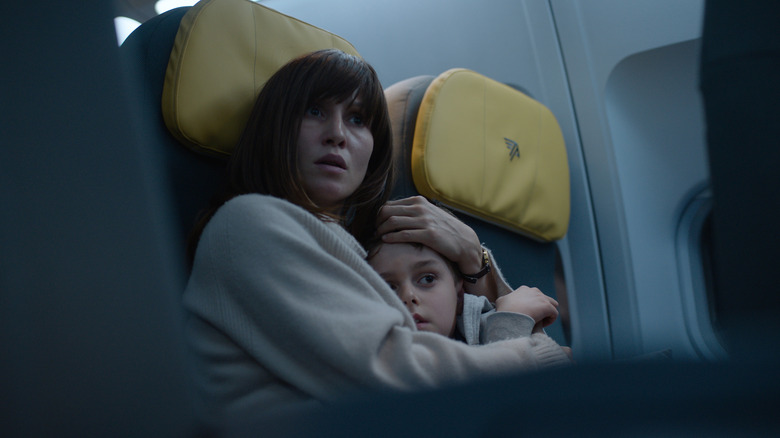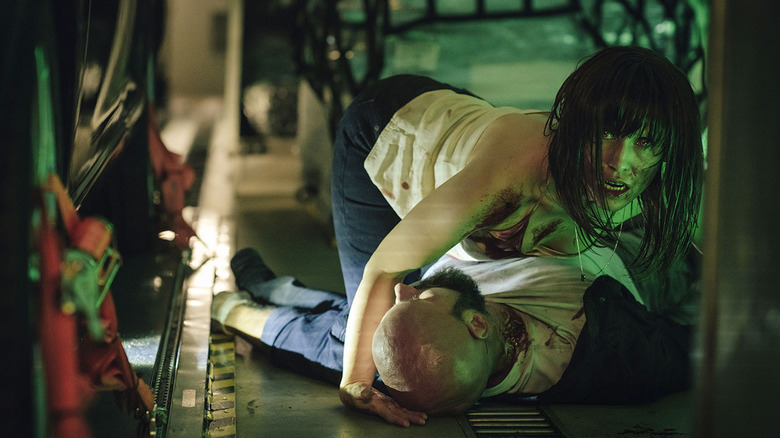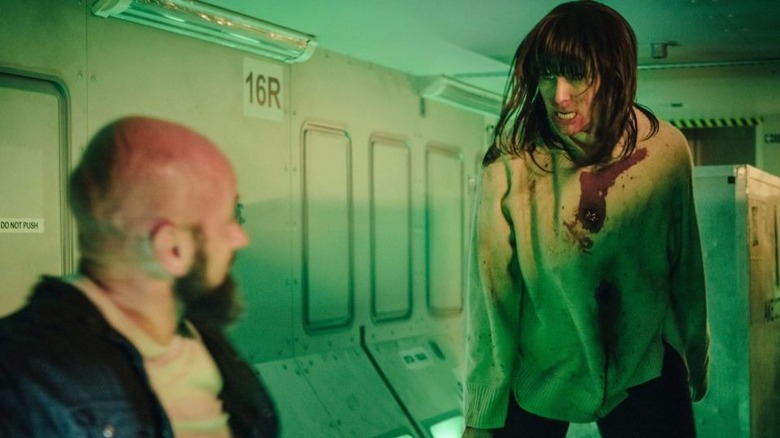Year Of The Vampire: Blood Red Sky Is A Genre-Bending Gore Fest
(Welcome to Year of the Vampire, a series examining the greatest, strangest, and sometimes overlooked vampire movies of all time in honor of "Nosferatu," which turns 100 this year.)
Imagine being a sick mother, traveling overnight on a flight with your young son, going to a country where you don't speak the language — all in hopes of a possible cure. Sounds stressful and heartbreaking, right? Well, what if that flight also happened to be hijacked by terrorists, and these dangerous, violent criminals grab your son? Then, they shoot you in the chest, leaving you for dead and your son trapped on a damned flight.
It's a heart-wrenching, albeit melodramatic, premise that exudes thriller-drama energy — but there's a twist. Nadja (Peri Baumeister) is no helpless, feeble invalid. In fact, she's actually a blood-thirsty monster herself, and underestimating her is about to bite those men in the ass (literally).
Netflix's "Blood Red Sky" (aka "Transatlantic 473") is a 2021 British-German film that defies genre conventions. Mixing equal parts action thriller and supernatural horror, director Peter Thorwarth offers audiences an exhilarating story of mystery, ever-increasing stakes, and plenty of bloodshed. It may be less "scary" than other horror films, and the action isn't eye-popping in the way a major tentpole release would be (there are no CGI battles or over-the-top stunts, like Nadja surfing the wing of the plane), but there is a lot in that two-hour runtime to keep you entertained — and it's exactly the kind of vampire movie that is perfect for Netflix.
What it brought to the genre
Netflix's take on vampires in "Blood Red Sky" is a refreshing reboot of an admittedly stale monster archetype. When "Nosferatu" hit German screens in 1922, vampires were a pretty recent addition to popular culture. Sure, the creature had existed in folklore for ages, and the origins of the "modern" romantic vampire are rooted in John Polidori's 1819 story "The Vampyre," but Bram Stoker's "Dracula" — the seminal modern-day vampire story — was only published in 1897. That's just 25 years before "Nosferatu" unabashedly ripped off the story, defining vampirism in the process. Now, a century later, vampires are prolific in fiction — but very little has changed about the lore (apart from Stephenie Meyer's questionable contributions). Heck, Netflix even released a new adaptation of "Dracula" (that first aired on BBC One) in 2020 — clearly, Bram Stoker's story is still very much in the popular consciousness.
"Blood Red Sky" responds to this by offering a radically different, yet more traditional, take on vampirism. Nadja is a folkloric demon from yesteryear. Rather than beautiful and charismatic, these vampires are more akin to vicious zombies — they don't need to charm you to enter into your home, nor do they live lavish lifestyles or have a elaborate secretive social structures. She's an aberration, desperately clawing to her last remaining vestiges of humanity before her bloodlust overtakes her mind. And unlike most vampire stories of the last few decades, the benefits of vampirism are far outweighed by the costs: Her violent impulses rob her of her personhood — represented by the progressive sloughing off of physical features, leaving her more and more disfigured and unidentifiable. It's a surprisingly poignant commentary on violence — while still allowing for plenty of deeply-satisfying (and gory) deaths.
"Blood Red Sky" is an undeniably unique vampire movie. It feels more like an action film than horror, but still manages to pay tribute to the roots of the genre — offering a clear homage to "Nosferatu" through the vampire design. Unlike the glossy, sexy bloodsuckers who have come to define these movies (even before "Twilight" made them sparkle), vampirism in the world of "Blood Red Sky" is a monstrous curse. It's also potentially devastating — whether intentional or not, the movie serves as a sobering allegory for pandemics: if Nadja's "illness" infects other people, it will spread rapidly and become an apocalyptic event. These are, of course, all familiar notes from the zombie genre, but it's nice seeing it used so effectively for vampires.
Twisty-turny genre-blending fun
"Blood Red Sky" might not be for everyone (the mixed Rotten Tomatoes score certainly suggests it's not), but I for one had a lot of fun watching the movie. I will admit, originally, my interest in the movie was driven by my appreciation for actor Dominic Purcell, who plays one of the hijackers, Berg. Even though he had a disappointingly small role in the overall film, there was plenty more to keep me engaged. The camp factor here is high, especially the sadistic villain Eightball (Alexander Scheer), whose inexplicable psychotic impulses defy logic but are very, very fun to watch. The relationship between young Elias (Carl Koch) and his mom injects some heart into the narrative, and while the ultimate resolution isn't exactly a "happy ending," it avoids feeling dour or fatalistic. The plot is thrilling in the first half — though it does drag a bit in the final act — and has the right mix of tension and suspense.
If you want your vampire movies to be oozing in sensual pleasures and filled with romance, this is not the movie for you. But, if you've ever wondered what it would be like if "Snakes on a Plane" or featured vampires and terrorists instead of pythons — well, this isn't exactly that, but it's pretty darn close. "Blood Red Sky" is a solid B-movie that demonstrates how "Nosferatu" is still informing stories today; what's more, it proves that there are still plenty of original vampire stories to tell.


